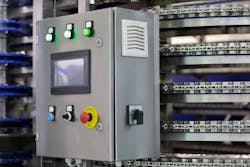Key highlights
- Modern packaging machine design leverages distributed and modular I/O systems, like field distribution blocks and IO-Link, to significantly reduce control cabinet size and wiring complexity.
- The standardization on Ethernet-based communication protocols has broadened the selection of interoperable control components and simplified network integration for packaging machinery.
- Increased connectivity down to the sensor level now provides a wealth of diagnostic and operational data that can be utilized for enhanced operator interfaces and more efficient machine maintenance.
Looking back over nearly 40 years in the business, the approach to automation has changed dramatically, and the impact on how we approach a new design barely resembles its former self.
In the early 1980s, when I was just cutting my teeth in this career, electronics for automation were big and clunky. Control panels had to be large to contain all the components. Devices ran hot, and that meant even bigger enclosures to help dissipate the heat. Power and control components were usually in the same enclosure and the general philosophy was to centralize the power/control enclosure and run all of the wires and cables out to the various parts of the machine or process.
The march of time has made the job of control design much easier, and one place this has really had an impact is in packaging machinery. I’ve had the good fortune to spend most of my career in and around packaging machinery. Various positions as an OEM/integrator and the past 14 years as an end user has provided me with a great ride through the evolution of automation.
When I first started out, I worked for a newly formed company that was just planting roots in the industry. We had the good fortune of leveraging some established relationships in the food industry to help with that growth, and it allowed us to explore new technologies and quickly become known for our innovation. I feel like I have been riding the crest of that wave for most of my career.
Back in those days, the Allen-Bradley PLC-2 and PLC-3 were in common use in the packaging industry with the PLC-5 just starting to make an appearance. Modicon and Siemens had similar, chassis-based platforms. They were big and robust and occupied a huge footprint in the electrical enclosure, but if you wanted computing horsepower, this is what you worked with.
In those days, some of those enclosures were big enough to stand in and, for that reason, were usually mounted against a wall with myriad conduit paths winding their way over the machine to get to all the functional devices.
Today, we approach packaging machinery in a very different direction. Programmable logic controllers (PLCs) and programmable automation controllers (PACs) are module-based, meaning that you only connect as many modules to the base controller as you need for your project without being confined to predefined chassis sizes that eat up extra space in a control cabinet.
After years of proprietary network protocols, usually manufacturer-driven, the industry has pretty much standardized on Ethernet or a derivative of it, and this means that controls designers aren’t necessarily limited to just the brand of the controller when selecting other components that will talk on the control network.
This open architecture has led to much more competition and helps to keep pricing down. This competition has also encouraged a lot of innovation, especially on products like operator terminals, as the various hardware producers introduce new features to keep their products on the radar of prospective users.
For the programmer, this unification of network protocols has been a blessing. Not too long ago, I used to carry around a tool bag just for the various cables and interface modules that I might need to connect to the various brands of devices on my production floor.
As we have upgraded older technologies in my manufacturing environment, I am reduced to just having an Ethernet cable and a USB to Ethernet dongle to connect to pretty much everything in our plant. Since wireless communication is pretty much standard any more, in many cases we have connected at least part of the operations level to our plant network, and we can reach many controllers without even plugging a cable in at all.
Through the use of network address translation, we can selectively add private network devices to our plant network—thus, wireless—during line startups or troubleshooting sessions and then remove them later to keep the operation technology (OT) out of the information technology (IT) environment.
Following on the previous point, the availability of devices from the OT level on the IT level has enabled an easy and obvious way to collect data from our operations lines and use that for critical decision-making at the management level. Several software providers have leveraged this availability to introduce products that place key performance indicators (KPIs) on a dashboard that is readily available to decision makers.
We jumped on this technology fairly early in the game, starting out with just overall equipment efficiency (OEE) mapping. This is done by defining what constitutes a good product run on a given shift and then counting products made at the subassembly level and finished cases leaving the end of the production line to determine if we are meeting our production goal for that shift.
For our operations, we have grown with the software developer to add quality assurance (QA) and maintenance management modules to the base solution.
Connectivity is the key element. In years past, this might be restricted to the controller and remote input/output (I/O) modules, operator stations and variable-frequency drives (VFDs) or servo drives, but the number and means of connecting to other devices has expanded greatly.
For example, VFDs and servo drives aren’t necessarily tied to the main control or power cabinet any more. Most hardware vendors now have drives that can be mounted right on the equipment, in close proximity to the motor they control. Further, servo-drive manufacturers have refined the technology behind them, so that some drive modules can house two drives in a common package, halving the footprint required in the panel for such devices. Others have integrated the drive and motor functions such that the servo drive is right there on the back of the motor housing.
All of this reduces both the design and construction of packaging machinery by reducing both the size of the control cabinet and the cable runs needed to reach the end devices.
I/O implementation has had a serious boost over the past few years. Formerly remote I/O would involve a chassis or module group mounted in a junction box somewhere on the machine where a cluster of devices was located.
While this method is still commonly used, the use of field distribution blocks (FDBs) has greatly improved both the deployment and connectivity to field devices. Field distribution boxes are quick-connect modules that mount right on the equipment, where the devices live.
The M12 connector is a popular choice for this type of connection, and most sensors and many output devices can be purchased with M12 as a standard connector, or the traditional four- or five-wire pigtail can be field-converted to an M12 connector.
The connection from the controller to the field distribution block is often a single cable/connector combining both power and communication in a single connection or, at the most, one cable for power and another for communications.
One key development has been a configurable field distribution block. This allows the designer to define a particular port as either input or output or both. Most FDBs come in either four- or eight-port versions, but those ports can also be split into two connections each for a total of up to 16 I/O connections per FBD.
Get your subscription to Control Design’s daily newsletter.
The ability to user-define the function of a port on an FBD not only helps at the design stage, but can quickly facilitate a field change if a spare connection is available.
Following closely on the development of the FDB is the introduction of what I call the smarter I/O system like IO-Link. This uses the same power and communication of a fieldbus device but connects it to a smart node where additional information is also available to the control system.
These smart nodes not only act as input/output mapping of the field devices, but can also provide information like the reliability of the signal. Not just a digital off or on, but how strong is the decision of off or on. Most sensors are IO-Link-ready, so the decision to include this extra level of data exchange is a fairly simple move.
Most providers of pneumatic and hydraulic manifolds that utilize fieldbus connectivity have also broadened their product lines to include I/O functionality on that same manifold assembly. This greatly helps with control design, as we don’t have to have a separate I/O block or remote I/O junction box if there is a fieldbus manifold present in the same area of concern.
So, what does all this mean for packaging machinery design? Using remote devices and I/O blocks means that we don’t have to build these huge main control cabinets anymore.
Cabinets can be smaller and, in most cases, can be easily designed to fit within the framework of the machine itself. Choosing remote devices and I/O blocks also means that we can reduce not only the number of conduits and cables leaving the control cabinet, but the physical size of those conductors, as well.
Going to a machine mounted I/O system means everything is plug-and-play, and, when a sensor or device needs replacing, it can be as easy as swapping out the device or swapping out the cable, if that is the failure point, with simple field connectors.
All this connectivity makes both design and maintaining of packaging equipment far more efficient. With all the extra data available, right down to the field device itself, some extra time spent on development of the operator-screen application can have huge benefits during the operation of the machine once it hits the packaging floor. If the controller can see it, the operating station can display it.
With the resolution available on operator screens, a lot of information can be displayed in a relatively small area, but the benefit to the operator or maintenance tech is enormous.
The future is bright, and technological innovation will continue to drive our businesses.
About the Author
Rick Rice
Contributing Editor
Rick Rice is a controls engineer at Trew Automation, a material handling manufacturer based in West Chester, Ohio. With over 38 years’ experience in the field of automation, Rice has designed and programmed everything from automotive assembly, robots, palletizing and depalletizing equipment, conveyors and forming machines for the plastics industry but most of his career has focused on OEM in the packaging machinery industry with a focus on R&D for custom applications.


